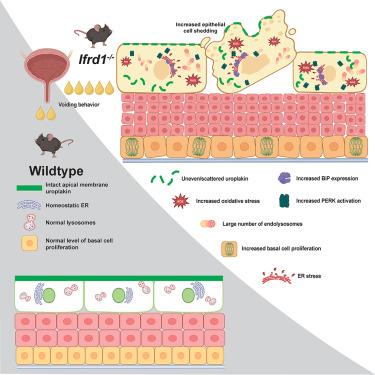维持膀胱上皮稳态需要 IFRD1
IF 4.6
2区 综合性期刊
Q1 MULTIDISCIPLINARY SCIENCES
引用次数: 0
摘要
膀胱功能的关键在于维持尿路上皮的稳态并在应激后迅速再生。在这里,我们确定了 IFRD1 在小鼠模型中维持尿路上皮平衡的关键作用。我们证明,小鼠膀胱在平衡状态下表达 IFRD1,尤其是在尿路上皮细胞中,而 IFRD1 的缺失会改变全局转录组,导致内溶酶体的显著积累和尿棘蛋白表达模式的失调。我们发现,IFRD1 与人尿路细胞中的 mRNA 翻译调节因子相互作用。Ifrd1的缺失会导致蛋白稳态紊乱、内质网(ER)应激增强(未折叠蛋白反应途径的PERK臂被激活)以及氧化应激增加。Ifrd1缺陷的膀胱表现出尿路上皮细胞凋亡/脱落、基底细胞增殖增强、表层细胞分化减少、尿路上皮通透性增加以及排尿行为异常。这些发现凸显了 IFRD1 在尿路神经元稳态中的关键作用,表明它有可能成为膀胱功能障碍的治疗靶点。本文章由计算机程序翻译,如有差异,请以英文原文为准。

IFRD1 is required for maintenance of bladder epithelial homeostasis
The maintenance of homeostasis and rapid regeneration of the urothelium following stress are critical for bladder function. Here, we identify a key role for IFRD1 in maintaining urothelial homeostasis in a mouse model. We demonstrate that the murine bladder expresses IFRD1 at homeostasis, particularly in the urothelium, and its loss alters the global transcriptome with significant accumulation of endolysosomes and dysregulated uroplakin expression pattern. We show that IFRD1 interacts with mRNA-translation-regulating factors in human urothelial cells. Loss of Ifrd1 leads to disrupted proteostasis, enhanced endoplasmic reticulum (ER stress) with activation of the PERK arm of the unfolded protein response pathway, and increased oxidative stress. Ifrd1-deficient bladders exhibit urothelial cell apoptosis/exfoliation, enhanced basal cell proliferation, reduced differentiation into superficial cells, increased urothelial permeability, and aberrant voiding behavior. These findings highlight a crucial role for IFRD1 in urothelial homeostasis, suggesting its potential as a therapeutic target for bladder dysfunction.
求助全文
通过发布文献求助,成功后即可免费获取论文全文。
去求助
来源期刊

iScience
Multidisciplinary-Multidisciplinary
CiteScore
7.20
自引率
1.70%
发文量
1972
审稿时长
6 weeks
期刊介绍:
Science has many big remaining questions. To address them, we will need to work collaboratively and across disciplines. The goal of iScience is to help fuel that type of interdisciplinary thinking. iScience is a new open-access journal from Cell Press that provides a platform for original research in the life, physical, and earth sciences. The primary criterion for publication in iScience is a significant contribution to a relevant field combined with robust results and underlying methodology. The advances appearing in iScience include both fundamental and applied investigations across this interdisciplinary range of topic areas. To support transparency in scientific investigation, we are happy to consider replication studies and papers that describe negative results.
We know you want your work to be published quickly and to be widely visible within your community and beyond. With the strong international reputation of Cell Press behind it, publication in iScience will help your work garner the attention and recognition it merits. Like all Cell Press journals, iScience prioritizes rapid publication. Our editorial team pays special attention to high-quality author service and to efficient, clear-cut decisions based on the information available within the manuscript. iScience taps into the expertise across Cell Press journals and selected partners to inform our editorial decisions and help publish your science in a timely and seamless way.
 求助内容:
求助内容: 应助结果提醒方式:
应助结果提醒方式:


